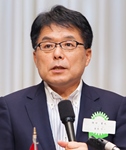Aging in the Tokyo Metropolitan Area
August 26, 2015
Mr. Hiroya Masuda
Professor, The University of Tokyo
Chairman, Japan Policy Council
�� Let me elaborate on the issue of population with a focus on ��aging in Tokyo,�� its future challenges and complexity. The Japan Policy Council pointed out last year that many municipalities across Japan are on the verge of vanishing, due to municipal mergers or renaming. Aging in Tokyo significantly increases our social security costs and it requires an adequate number and size of municipalities capable of providing sufficient services. I must say the future doesn��t look very promising.
Let me elaborate on the issue of population with a focus on ��aging in Tokyo,�� its future challenges and complexity. The Japan Policy Council pointed out last year that many municipalities across Japan are on the verge of vanishing, due to municipal mergers or renaming. Aging in Tokyo significantly increases our social security costs and it requires an adequate number and size of municipalities capable of providing sufficient services. I must say the future doesn��t look very promising.
��Let me start with an overview of the demographic trends in Japan. Our total population had remained relatively stable from the Kamakura era (1192-1333) up to the Edo era (1603-1868) with a moderate growth. The arrival of the Meiji era brought a rapid growth, marking a sharp increase by 90 million people over 140 years. The Japanese population peaked in 2008 at 128 million and then started to decline sharply. According to the National Institute of Population and Social Security Research, the Japanese population is projected to keep declining to 97.08 million by 2050 and 49.59 million by 2100. Being a densely populated country, population decline can give us more space and comfort. We can learn from Germany with 80 million people or France with 60 million people about how to make the economy work with such a population size.
��The Japanese government launched various measures to try and maintain 100 million people by 2060, led by the new Headquarters for Vitalizing Towns, People and Jobs with Minister Ishiba. To achieve this ambitious goal, we must raise the birth rate from the current 1.42 to 1.8 by 2030 and further to 2.07 by 2045.
��As many as 2.7 million babies were born annually during the post-war baby boom between 1947 and 1949, which reached the age 66 to 68 and became ��older population�� this year. The second-generation baby boomers (born between 1971 and 1974) that totaled 2.1 million also reached age 40 last year. As there exists no third-generation baby boomer cohort, the number of births keeps decreasing. Total fertility rate (TFR) had long exceeded 2.0 until 1975, but started to decline and finally hit 1.26 in 2005. The number of newly-born babies also keeps declining and totaled just above 1 million in 2014, less than half of the number of baby boomers. It is projected that the number will further drop to 0.9 million in three years. I must repeat that the future looks gloomy unless we create a social environment that will raise TFR and the number of births.
��Demographers uniformly note that once TFR drops below 1.5, there is no hope for recovery. TFR in Sweden once hit 1.5 but managed to regain 2.0. Likewise TFR in France marks 2.01 today, making a recovery from 1.66. Both countries accepted a large number of immigrants and introduced common-law marriages. The labor force in Japan totals 65 million today, but it is projected to decrease by 9 million in 15 years. Various measures taken by the European countries are suggestive for us to enhance bold and in-depth measures towards encouraging the younger generation to get married, providing support to female workers so that they can pursue their careers as they experience various life events (marriage, pregnancy, childbirth and childcare) as well as securing a family-friendly working environment with a good work-life balance.
��The aging of our population will accelerate in 10 years when the baby-boomers join the ��late-stage elderly (aged 75 and over)�� and become more likely to need medical and nursing-care services. Many people had moved into Tokyo during the high economic growth period and today, as many as one-third of the late-stage elderly reside in the Tokyo Metropolitan Area. Growth of the nuclear family has resulted in the emergence of ��elder-to-elder nursing�� or the elderly living alone. The Ministry of Health, Labour and Welfare aims to provide medical and long-term care in local communities. Let me emphasize the need to secure financial resources to ensure a comprehensive care and service system, by raising the consumption tax if necessary.
��Another major concern is a serious shortage of nursing care workers. Data published by the Ministry of Health, Labour and Welfare this June estimated that there would be 2.53 million people who need care but those who can provide care would total 2.15 million at most. So how can we fill this gap of 380,000 people needed to provide care? We must not forget that the number of younger generation keeps declining who plays an instrumental role in the labour force. I believe such precious human resources should engage in meaningful and rewarding high-value added jobs. With this in mind, we must transform all the industries to become less dependent on human resources. For example, the ��nursing care suits (wearable mobile suits)�� can reduce the burden on caregivers. Such technological innovation will lead to sound economic development. As I close my speech, let me emphasize that the issues of aging and falling population can stimulate innovative ideas and developments that will eventually contribute to a better nation-building.